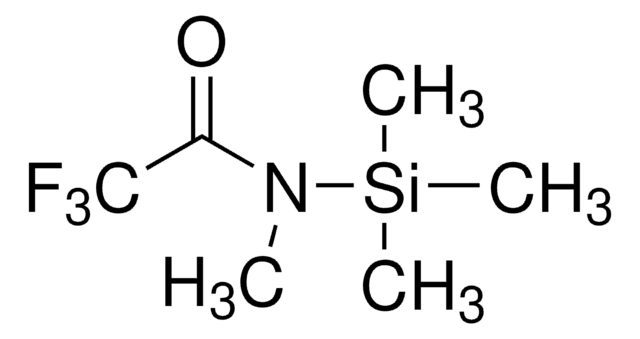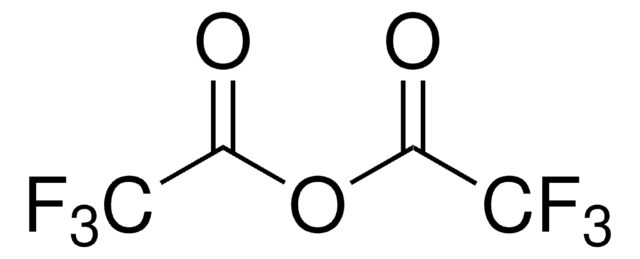Key Documents
00942
N-tert-Butyldimethylsilyl-N-methyltrifluoroacetamide
for GC derivatization, LiChropur™, ≥95.0% (GC), with 1% tert-Butyldimethylchlorosilane
Synonim(y):
N-Methyl-N-tert-butyldimethylsilyltrifluoroacetamide, MTBSTFA + 1% TBDMSCl, Silylating mixture VI
About This Item
Polecane produkty
product name
N-tert-Butyldimethylsilyl-N-methyltrifluoroacetamide with 1% tert-Butyldimethylchlorosilane, for GC derivatization, LiChropur™, ≥95.0% (GC)
klasa czystości
for GC derivatization
Poziom jakości
Próba
≥95.0% (GC)
Postać
liquid
jakość
LiChropur™
przydatność reakcji
reagent type: derivatization reagent
reaction type: Silylations
metody
gas chromatography (GC): suitable
zanieczyszczenia
0.5-1.5% tert-butyldimethylchlorosilane
temp. przechowywania
2-8°C
ciąg SMILES
CN(C(=O)C(F)(F)F)[Si](C)(C)C(C)(C)C
InChI
1S/C9H18F3NOSi/c1-8(2,3)15(5,6)13(4)7(14)9(10,11)12/h1-6H3
Klucz InChI
QRKUHYFDBWGLHJ-UHFFFAOYSA-N
Szukasz podobnych produktów? Odwiedź Przewodnik dotyczący porównywania produktów
Powiązane kategorie
Opis ogólny
Zastosowanie
- Organic acid profile in human serum by gaschromatography/mass spectrometry (GC/MS).
- Nerveagents and their breakdown products by GC–MS-MS method.
Informacje prawne
produkt powiązany
Hasło ostrzegawcze
Warning
Zwroty wskazujące rodzaj zagrożenia
Zwroty wskazujące środki ostrożności
Klasyfikacja zagrożeń
Eye Irrit. 2 - Flam. Liq. 3 - Skin Irrit. 2
Kod klasy składowania
3 - Flammable liquids
Klasa zagrożenia wodnego (WGK)
WGK 3
Temperatura zapłonu (°F)
113.0 °F - closed cup
Temperatura zapłonu (°C)
45 °C - closed cup
Wybierz jedną z najnowszych wersji:
Masz już ten produkt?
Dokumenty związane z niedawno zakupionymi produktami zostały zamieszczone w Bibliotece dokumentów.
Klienci oglądali również te produkty
Produkty
Results of a study involving the ability few Fluka silylating reagents to form GC-MS-compatible trimethylsilylmethyl derivatives of NSAIDs
Nasz zespół naukowców ma doświadczenie we wszystkich obszarach badań, w tym w naukach przyrodniczych, materiałoznawstwie, syntezie chemicznej, chromatografii, analityce i wielu innych dziedzinach.
Skontaktuj się z zespołem ds. pomocy technicznej









